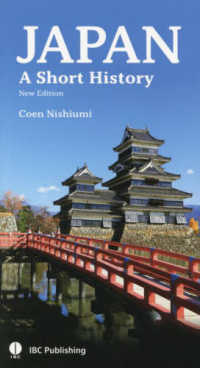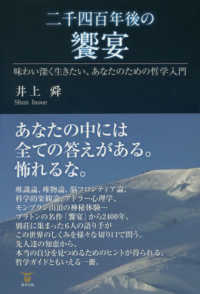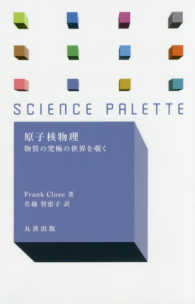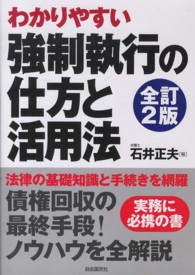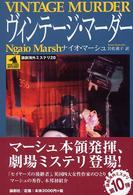- ホーム
- > 洋書
- > 英文書
- > Cinema / Film
Full Description
Moving images have become an increasingly common feature in a wide range of museums, which are frequently populated with screens and audio-visual projections. But when did films start to be displayed in museum galleries? And what are the issues at stake when showing moving images in exhibition spaces?
With an innovative and strongly interdisciplinary theoretical framework, this book offers an extensive investigation of the use of audio-visuals in exhibition design. Highlighting the continuities and fractures between different periods, contexts and practices, Elisa Mandelli shows the deep influence of audio-visuals on the configuration of the exhibition space, as well as on the relationship between museums and their visitors.
Contents
Illustrations
Acknowledgments
Preface
Introduction
Part I. BETWEEN HISTORY AND MODERNITY: FILMS AND AUDIO-VISUALS IN EXHIBITIONS IN THE TWENTIETH CENTURY
Chapter 1. Cinema, museums, memory, and education
'The ocular evidence that is truthful and infallible par excellence': cinema, museums and the preservation of memory
The educational role of cinema
Cinema, museums, and the demands of modern life
Chapter 2. 'A dimly-lighted corner'. Moving images in museums in the first decades of the twentieth century
Museums and movies: cinema at the Imperial Institute
Films as exhibits: moving images inside the museums' galleries
An archive for the preservation of films at the Imperial War Museum
How to show film footage? Showing the Imperial War Museum film collection
Trenches, tanks and the explosion of a mine: Mutoscopes at the Imperial War Museum (1924-38)
The Mutoscopes between novelty and obsolescence
Exception or rule? Debating the use of moving images in museum galleries
Chapter 3. Moving images in museums, world's fairs and avant-garde exhibition design
Twentieth century avant-gardes and exhibition design
The cinematism of the exhibition space: El Lissitzky
Cinema and the dynamism of modern life: Moholy-Nagy's Room of the Present
'The paradise of the exhibitor': museums and world's fairs
Audio-visual devices at the New York Museum of Science and Industry
Chapter 4. The multi-media museum: film and audio-visuals in museums, 1960s-70s
Museums and films from UNESCO to world's fairs
The exhibition as a mosaic: Marshall McLuhan and Harley Parker
Museums and the 'AV revolution'
Part II. THE MUSEUM AS A CINEMATIC SPACE: MUSEUMS AND AUDIO-VISUALS IN THE TWENTY-FIRST CENTURY
Chapter 5. From the museum experience to the museum as an experience
From objects to visitors: the virtualisation of the museum
Museums and the 'experience economy'
Moving images and the museum experience
Chapter 6. Audio-visuals in exhibitions
Archival footage
Documentaries
Reconstructions and fictional films
Video testimonies
Chapter 7. The Museum and its spectres
The mirror and the portrait: The Widespread Museum of the Resistance in Turin
The 'ghosts' of the witnesses: The In Flanders Fields Museum
Phantasmagoria
Chapter 8. A walk through images
Galleries, projections, and cinematic effects: The Trento Tunnels
A film in space: Peopling the Palaces at Venaria Reale
Chapter 9. New interpretations of the movie theatre
'A bit like a large cinema': The Big Picture Show at the Imperial War Museum North
A movie theatre inside the museum: The Historial Charles de Gaulle
Chapter 10. Touching images
Touching, browsing: interactive tables
Rewriting space: The Museum Laboratory of the Mind
Interactions / interrelations
Conclusions
Bibliography
Index

